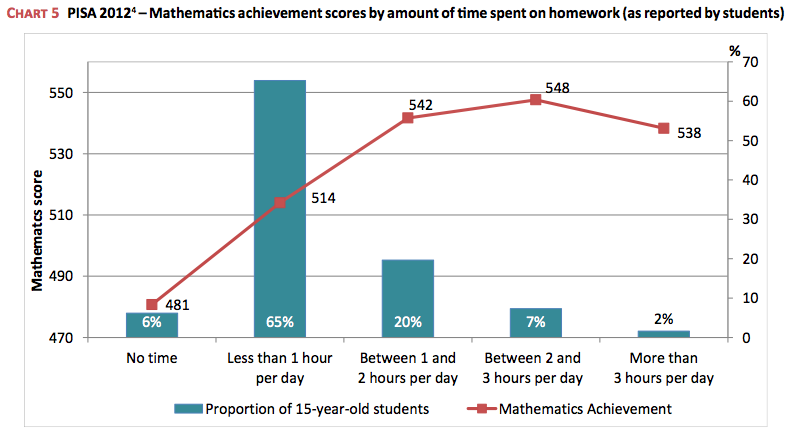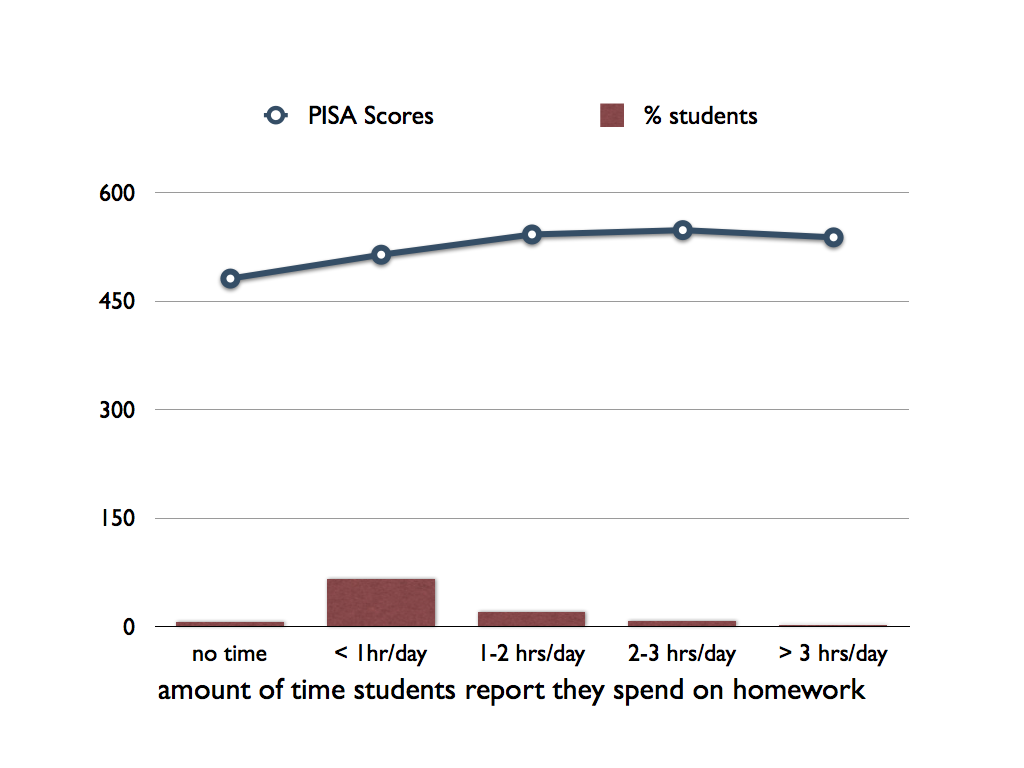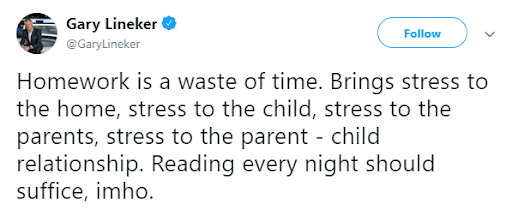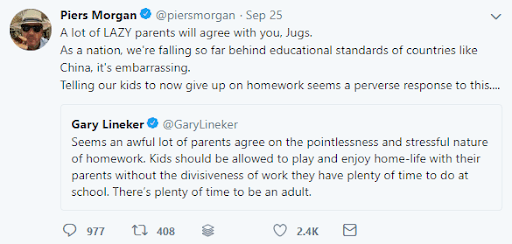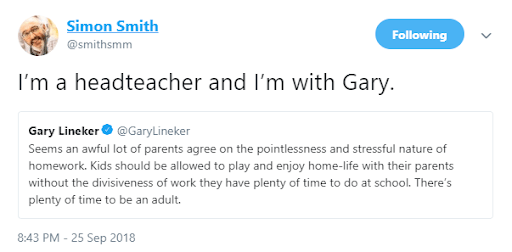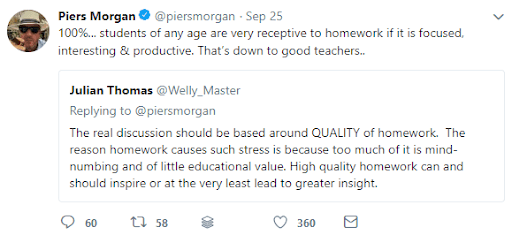How much homework is enough
How much homework is enough
The short answer is: It depends?

The Council of Ministers of Education Canada started publishing Assessment Matters! in 2013. These are a series of short summaries of specific educational issues that emerge from four different national or international assessment tests:
The value of homework for learning is a much debated issue. (See Rethinking Homework by Alfie Kohn and The Case For and Against Homework by Robert J. Marzano and Debra J. Pickering.) Recently, Assessment Matters! published a summary of findings from PCAP, PISA, and PIRLS(pdf) that summarizes what we’ve learned about how much homework is enough. This is what they learned:
Numeracy Note 1: Look closely at this graph. The scale goes from 440 to 540. The differences between the bars would appear much smaller if the graph started from 0 on the left and went to 540 on the right. This suggests that while there may be some gains to be had from homework in the middle years those gains may be rather smaller than implied visually by this graph. The same is true for the graph above (it goes from 520 to 570 rather than 0 to 570).
Numeracy Note 2: This graph shares the same issues with the scale represented (it displays values from 470 to 550 rather than 0 to 550) as those above. The left hand scale is measuring PISA test scores. The percentage scale on the right goes from 0 to 70; it measures the percentage of students who do different amounts of homework each day. The scales measure different things. Had the right hand scale started from 0, the right hand percentage scale, also starting from 0, would leave a rather different visual impression on the reader.
This graphs shows the same information using a common scale:
These last three graphs represent the same information. They have quite different visual impacts. Go back and take another look at the first graph above; notice anything?
Further Reading
There are many nuances that go into determining the effectiveness of homework. «Having Homework» as opposed to well designed purposeful practice that students can reasonably accomplish independently aren’t necessarily the same thing. The Canadian Council on Learning, having done a systematic review of the research on homework concludes: Homework helps, but not always.(pdf)
See also: Homework: What the Research Says(pdf) by Harris Cooper and Rethinking Homework(pdf) by Cathy Vatterott.
How much homework did your teachers assign when you were in school? How much of that homework did you do? How much homework do you typically assign to your students? How much of it do they typically do? How do you think homework best supports student learning?
photo credit: creative commons licensed (BY-NC-ND) flickr photo by MarkGuitarPhoto
Homework — How much is too much? How much is enough?
Homework in TEFL teaching is something that seems to divide opinion among teachers. Some feel that homework is an integral to students improving while others feel that class time is sufficient. In this post, I will cover how much homework to set along with what to set and what I recommend against setting.
How much should I set?
Lots of schools have policies which state that students should get a certain number of pieces of homework each week but what I’ve found is that this causes additional unnecessary stress to the teacher as we have to find something suitable and hand it out safe in the knowledge that most of the students aren’t going to do it anyway.
My recommendation is that if you see students every day, 2 pieces of homework is sufficient while if you see them less then one is suitable. For example, if I see students on a Tuesday and Thursday, I will set a piece of homework on the Thursday night which gives them 5 nights to complete it. If I see them once a week then I always set a homework; otherwise the first part of the next lesson is lost to re-explaining the previous lesson’s content.
Even your more motivated students will quickly lose interest if a piece of homework is set every night so make sure that you avoid setting too much ‘official’ homework.
For the rest of this post, I am going to write as if it is a class I see every day Monday to Friday. That being said a lot of the tips contained below can easily be applied or modified slightly in order to fit less frequent classes.
Before you set the homework
This is probably the most important tip that will be contained in this post. Do not be militant about homework. No matter what the age, students are very resistant to being ordered to do homework. If it’s kids, talk with the parents about the importance of their child completing homework and if it’s not done on a regular basis, include it in that child’s report. With teens and adults, I have a very clear policy which I outline on day 1 of the course:
“I am not going to shout at you if you don’t do your homework but please remember that the students who make the most progress are the ones who complete homework. Therefore, I will set homework; whether you do it or not is your responsibility. If you think you are getting too much (very unlikely in my classes) then please tell me. If you want more, you crazy person, speak with me and I can give you more.”
There is nothing more frustrating than trying to get demotivated students to study outside of the class but you will always have some who are very dedicated and will complete everything you set them (assuming you don’t set too much).
Also, negotiate deadlines with the students for longer pieces of homework (more about this below). I usually tell them that their homework needs to be handed in the following week but ask them to decide among themselves which day they want to hand it in. This empowers students and also makes them more likely to do it because they had a hand in choosing the date. If you militantly set dates, you will always get students who won’t do it just to spite you.
What should I set?
In a five-day week, I usually set one large piece of homework and encourage students to do some self-study to complement it. By large piece of homework, I mean a writing task or preparation for a speaking task like a presentation or preparing a role-play in pairs. Along with that, I often recommend the following tasks for each of the skills.
“I read a really interesting article about … yesterday and it said that …”
It also means that students don’t have to understand every word and therefore won’t waste hours translating unnecessary vocabulary.
What not to set
You may have noticed that I have not included grammar on here. That is because I do not set structured grammar homework tasks. When I teach a piece of grammar, it is a 3 step process:
I’ve found this to be highly effective and the students appreciate not being given grammar homework which is often boring.
I also tend to avoid setting homework that involves writing lots of sentences as it demotivates students. Multiple choice and fill in the blank both involve actually writing very little and the students are more likely to do it.
I am currently in the process of doing an EdTech course run by a gentleman named Todd Beuckens (www.elllo.org) and his method of setting homework is fantastic. He creates quizzes using Google forms that are then correlated automatically into a spreadsheet and also are self-grading (the student gets the correct answers at the end). These quizzes are ideal for a Facebook group or other social media outlet that you use for your teaching but can also be placed on a blog. This means that students can do as much or as little homework as they wish and you can monitor it using Google Drive.
For me, this approach is ideal because it means students don’t have to work in their books. They can use their phones which means they can complete the homework anywhere at any time. Also, it means that you can save valuable class time because you don’t have to review homework. That being said, make sure that students know that they can approach you at any time if they don’t understand why a particular answer was correct/incorrect.
The world has moved on and we undoubtedly live in the age of technology. As teachers, it is our duty to evolve with the times if we want to stay relevant and if we want to motivate the digital generations.
On the whole, a student who wants to improve should be doing the homework that you set but also be doing independent study. All we can do as teachers is to provide the resources; the students are the ones who have to be motivated enough to study ‘off their own back’.
What’s the Right Amount of Homework?
Decades of research show that homework has some benefits, especially for students in middle and high school—but there are risks to assigning too much.
Many teachers and parents believe that homework helps students build study skills and review concepts learned in class. Others see homework as disruptive and unnecessary, leading to burnout and turning kids off to school. Decades of research show that the issue is more nuanced and complex than most people think: Homework is beneficial, but only to a degree. Students in high school gain the most, while younger kids benefit much less.
The National PTA and the National Education Association support the “10-minute homework guideline”—a nightly 10 minutes of homework per grade level. But many teachers and parents are quick to point out that what matters is the quality of the homework assigned and how well it meets students’ needs, not the amount of time spent on it.
The guideline doesn’t account for students who may need to spend more—or less—time on assignments. In class, teachers can make adjustments to support struggling students, but at home, an assignment that takes one student 30 minutes to complete may take another twice as much time—often for reasons beyond their control. And homework can widen the achievement gap, putting students from low-income households and students with learning disabilities at a disadvantage.
However, the 10-minute guideline is useful in setting a limit: When kids spend too much time on homework, there are real consequences to consider.
Small Benefits for Elementary Students
As young children begin school, the focus should be on cultivating a love of learning, and assigning too much homework can undermine that goal. And young students often don’t have the study skills to benefit fully from homework, so it may be a poor use of time (Cooper, 1989; Cooper et al., 2006; Marzano & Pickering, 2007). A more effective activity may be nightly reading, especially if parents are involved. The benefits of reading are clear: If students aren’t proficient readers by the end of third grade, they’re less likely to succeed academically and graduate from high school (Fiester, 2013).
For second-grade teacher Jacqueline Fiorentino, the minor benefits of homework did not outweigh the potential drawback of turning young children against school at an early age, so she experimented with dropping mandatory homework. “Something surprising happened: They started doing more work at home,” Fiorentino writes. “This inspiring group of 8-year-olds used their newfound free time to explore subjects and topics of interest to them.” She encouraged her students to read at home and offered optional homework to extend classroom lessons and help them review material.
Moderate Benefits for Middle School Students
As students mature and develop the study skills necessary to delve deeply into a topic—and to retain what they learn—they also benefit more from homework. Nightly assignments can help prepare them for scholarly work, and research shows that homework can have moderate benefits for middle school students (Cooper et al., 2006). Recent research also shows that online math homework, which can be designed to adapt to students’ levels of understanding, can significantly boost test scores (Roschelle et al., 2016).
There are risks to assigning too much, however: A 2015 study found that when middle school students were assigned more than 90 to 100 minutes of daily homework, their math and science test scores began to decline (Fernández-Alonso, Suárez-Álvarez, & Muñiz, 2015). Crossing that upper limit can drain student motivation and focus. The researchers recommend that “homework should present a certain level of challenge or difficulty, without being so challenging that it discourages effort.” Teachers should avoid low-effort, repetitive assignments, and assign homework “with the aim of instilling work habits and promoting autonomous, self-directed learning.”
In other words, it’s the quality of homework that matters, not the quantity. Brian Sztabnik, a veteran middle and high school English teacher, suggests that teachers take a step back and ask themselves these five questions:
More Benefits for High School Students, but Risks as Well
By the time they reach high school, students should be well on their way to becoming independent learners, so homework does provide a boost to learning at this age, as long as it isn’t overwhelming (Cooper et al., 2006; Marzano & Pickering, 2007). When students spend too much time on homework—more than two hours each night—it takes up valuable time to rest and spend time with family and friends. A 2013 study found that high school students can experience serious mental and physical health problems, from higher stress levels to sleep deprivation, when assigned too much homework (Galloway, Conner, & Pope, 2013).
Homework in high school should always relate to the lesson and be doable without any assistance, and feedback should be clear and explicit.
Teachers should also keep in mind that not all students have equal opportunities to finish their homework at home, so incomplete homework may not be a true reflection of their learning—it may be more a result of issues they face outside of school. They may be hindered by issues such as lack of a quiet space at home, resources such as a computer or broadband connectivity, or parental support (OECD, 2014). In such cases, giving low homework scores may be unfair.
Since the quantities of time discussed here are totals, teachers in middle and high school should be aware of how much homework other teachers are assigning. It may seem reasonable to assign 30 minutes of daily homework, but across six subjects, that’s three hours—far above a reasonable amount even for a high school senior. Psychologist Maurice Elias sees this as a common mistake: Individual teachers create homework policies that in aggregate can overwhelm students. He suggests that teachers work together to develop a school-wide homework policy and make it a key topic of back-to-school night and the first parent-teacher conferences of the school year.
Parents Play a Key Role
Homework can be a powerful tool to help parents become more involved in their child’s learning (Walker et al., 2004). It can provide insights into a child’s strengths and interests, and can also encourage conversations about a child’s life at school. If a parent has positive attitudes toward homework, their children are more likely to share those same values, promoting academic success.
But it’s also possible for parents to be overbearing, putting too much emphasis on test scores or grades, which can be disruptive for children (Madjar, Shklar, & Moshe, 2015). Parents should avoid being overly intrusive or controlling—students report feeling less motivated to learn when they don’t have enough space and autonomy to do their homework (Orkin, May, & Wolf, 2017; Patall, Cooper, & Robinson, 2008; Silinskas & Kikas, 2017). So while homework can encourage parents to be more involved with their kids, it’s important to not make it a source of conflict.
The Pros and Cons of Homework
Homework is a word that most students dread hearing. After hours upon hours of sitting in class, the last thing we want is more schoolwork over our precious weekends. While it’s known to be a staple of traditional schooling, homework has also become a rather divise topic. Some feel as though homework is a necessary part of school, while others believe that the time could be better invested. Should students have homework? Have a closer look into the arguments on both sides to decide for yourself.
Photo by energepic.com from Pexels
Why Should Students Have Homework?
1. Homework Encourages Practice
Many people believe that one of the positive effects of homework is that it encourages the discipline of practice. While it may be time consuming and boring compared to other activities, repetition is needed to get better at skills. Homework helps make concepts more clear, and gives students more opportunities when starting their career.
2. Homework Gets Parents Involved
Homework can be something that gets parents involved in their children’s lives if the environment is a healthy one. A parent helping their child with homework makes them take part in their academic success, and allows for the parent to keep up with what the child is doing in school. It can also be a chance to connect together.
3. Homework Teaches Time Management
Homework is much more than just completing the assigned tasks. Homework can develop time management skills, forcing students to plan their time and make sure that all of their homework assignments are done on time. By learning to manage their time, students also practice their problem-solving skills and independent thinking. One of the positive effects of homework is that it forces decision making and compromises to be made.
4. Homework Opens A Bridge Of Communication
Homework creates a connection between the student, the teacher, the school, and the parents. It allows everyone to get to know each other better, and parents can see where their children are struggling. In the same sense, parents can also see where their children are excelling. Homework in turn can allow for a better, more targeted educational plan for the student.
5. Homework Allows For More Learning Time
Homework allows for more time to complete the learning process. School hours are not always enough time for students to really understand core concepts, and homework can counter the effects of time shortages, benefiting students in the long run, even if they can’t see it in the moment.
6. Homework Reduces Screen Time
Many students in North America spend far too many hours watching TV. If they weren’t in school, these numbers would likely increase even more. Although homework is usually undesired, it encourages better study habits and discourages spending time in front of the TV. Homework can be seen as another extracurricular activity, and many families already invest a lot of time and money in different clubs and lessons to fill up their children’s extra time. Just like extracurricular activities, homework can be fit into one’s schedule.
Photo by energepic.com from Pexels
The Other Side: Why Homework Is Bad
1. Homework Encourages A Sedentary Lifestyle
Should students have homework? Well, that depends on where you stand. There are arguments both for the advantages and the disadvantages of homework.
While classroom time is important, playground time is just as important. If children are given too much homework, they won’t have enough playtime, which can impact their social development and learning. Studies have found that those who get more play get better grades in school, as it can help them pay closer attention in the classroom.
Children are already sitting long hours in the classroom, and homework assignments only add to these hours. Sedentary lifestyles can be dangerous and can cause health problems such as obesity. Homework takes away from time that could be spent investing in physical activity.
2. Homework Isn’t Healthy In Every Home
While many people that think homes are a beneficial environment for children to learn, not all homes provide a healthy environment, and there may be very little investment from parents. Some parents do not provide any kind of support or homework help, and even if they would like to, due to personal barriers, they sometimes cannot. Homework can create friction between children and their parents, which is one of the reasons why homework is bad.
3. Homework Adds To An Already Full-Time Job
School is already a full-time job for students, as they generally spend over 6 hours each day in class. Students also often have extracurricular activities such as sports, music, or art that are just as important as their traditional courses. Adding on extra hours to all of these demands is a lot for children to manage, and prevents students from having extra time to themselves for a variety of creative endeavors. Homework prevents self discovery and having the time to learn new skills outside of the school system. This is one of the main disadvantages of homework.
4. Homework Has Not Been Proven To Provide Results
Endless surveys have found that homework creates a negative attitude towards school, and homework has not been found to be linked to a higher level of academic success.
The positive effects of homework have not been backed up enough. While homework may help some students improve in specific subjects, if they have outside help there is no real proof that homework makes for improvements.
It can be a challenge to really enforce the completion of homework, and students can still get decent grades without doing their homework. Extra school time does not necessarily mean better grades — quality must always come before quantity.
Accurate practice when it comes to homework simply isn’t reliable. Homework could even cause opposite effects if misunderstood, especially since the reliance is placed on the student and their parents — one of the major reasons as to why homework is bad. Many students would rather cheat in class to avoid doing their homework at home, and children often just copy off of each other or from what they read on the internet.
5. Homework Assignments Are Overdone
The general agreement is that students should not be given more than 10 minutes a day per grade level. What this means is that a first grader should be given a maximum of 10 minutes of homework, while a second grader receives 20 minutes, etc. Many students are given a lot more homework than the recommended amount, however.
On average, college students spend as much as 3 hours per night on homework. By giving too much homework, it can increase stress levels and lead to burn out. This in turn provides an opposite effect when it comes to academic success.
Conclusion
The pros and cons of homework are both valid, and it seems as though the question of ‘‘should students have homework?’ is not a simple, straightforward one. Parents and teachers often are found to be clashing heads, while the student is left in the middle without much say.
It’s important to understand all the advantages and disadvantages of homework, taking both perspectives into conversation to find a common ground. At the end of the day, everyone’s goal is the success of the student.
The Great British Homework Debate 2022 – Is It Necessary At Primary School?
Alexander Athienitis
The homework debate is never much out of the news. Should homework be banned? Is homework at primary school a waste of time? Do our children get too much homework?
Not long ago UK-based US comedian Rob Delaney set the world alight with a tweet giving his own personal view of homework at primary school. We thought, as an organisation that provides maths homework support on a weekly basis, it was time to look at the facts around the homework debate in primary schools, as well of course as reflecting the views of celebrities and those perhaps more qualified to offer an opinion!
This blog is part of our series of blogs designed for teachers, schools and parents supporting home learning.
Here’s how Rob Delaney kicked things off
Gary Lineker leant his support with the following soundbite:
And even Piers Morgan weighed in, with his usual balance of tact and sensitivity:
A very experienced and knowledgeable Headteacher, Simon Smith who has a well-earned following on Twitter (for someone working in education, not hosting Match of the Day) also put his neck on the line and, some might think controversially, agreed with the golden-heeled Crisp King of Leicester…
Fortunately Katharine Birbalsingh, Conservative Party Conference keynote speaker and Founding Headteacher of the Michaela School, was on hand to provide the alternative view on the importance of homework. Her op-ed piece in the Sun gave plenty of reasons why homework should not be banned.
She was informative and firm in her article stating: “Homework is essential for a child’s education because revisiting the day’s learning is what helps to make it stick.”
KS2 Maths Games and Activities Pack
A FREE downloadable games and activity pack, including 20 home learning maths activities for KS2 children to complete on their own or with a partner.
How much homework do UK primary school children get?
Sadly, there’s little data comparing how much homework primary school-aged children in the UK and across the globe complete on a weekly basis. A study of teenagers used by The Telegraph shows that American high-schoolers spend an average of 6.1 hours per week compared with 4.9 hours per week of homework each week for UK-based teens.
Up until 2012 the Department of Education recommended an hour of homework a week for primary school Key Stage 1 children (aged 4 to 7) and half an hour a day for primary school Key Stage 2 children (aged 7-11). Many primary schools still use this as a guideline.
Teachers, parents and children in many schools across the land have seen more changes of homework policy than numbers of terms in some school years.
A no homework policy pleases only a few; a grid of creative tasks crowd-sourced from the three teachers bothered to give their input infuriates many (parents, teachers and children alike). For some parents, no matter how much homework is set, it’s never enough; for others, even asking them to fill in their child’s reading record once a week can be a struggle due to a busy working life.
Homework is very different around the world
We’d suggest that Piers Morgan’s argument for homework in comparing the UK’s economic and social progress with China’s in recent years based on total weekly homework hours is somewhat misguided – we can’t put their emergence as the world’s (if not already, soon to be) leading superpower exclusively down to having their young people endure almost triple the number of hours spent completing homework as their Western counterparts.
Nonetheless, there’s certainly a finer balance to strike between the 14 hours a week suffered by Shanghainese school-attendees and none whatsoever. Certainly parents in the UK spend less time each week helping their children than parents in emerging economies such as India, Vietnam and Colombia (Source: Varkey Foundation Report).
Disadvantages of homework at primary school
Delaney, whose son attends a London state primary school, has made it plain that he thinks his kids get given too much homework and he’d rather have them following more active or creative pursuits: drawing or playing football. A father of four sons and a retired professional footballer Gary Linaker was quick to defend this but he also has the resources to send his children to top boarding schools which generally provide very structured homework or ‘prep’ routines.
As parents Rob and Gary are not alone. According to the 2018 Ofsted annual report on Parents Views more than a third of parents do not think homework in primary school is helpful to their children. They cite the battles and arguments it causes not to mention the specific challenges it presents to families with SEND children many of whom report serious damage to health and self-esteem as a result of too much or inappropriate homework.
It’s a truism among teachers that some types of homework tells you very little about what the child can achieve and much more about a parent’s own approach to the work. How low does your heart sink when your child comes back with a D & T project to create Stonehenge and you realise it’s either an all-nighter with glue, cardboard and crayons for you, or an uncompleted homework project for your child!
Speaking with our teacher hats on, we can tell you that homework is often cited in academic studies looking at academic progress in primary school-aged children as showing minimal to no impact.
Back on Twitter, a fellow teacher was able to weigh-in with that point:
Benefits of homework at primary school
So what are the benefits of homework at primary school? According to the Education Endowment Foundation (EEF) (the key research organisations dedicated to breaking the link between family income and educational achievement) the impact of homework at primary is low, but it also doesn’t cost much.
They put it at a “+2 months” impact against a control of doing nothing. To put this into context, 1-to-1 tuition is generally seen as a +5 months impact but it’s usually considered to be expensive.
“There is some evidence that when homework is used as a short and focused intervention it can be effective in improving students’ attainment … overall the general benefits are likely to be modest if homework is more routinely set.”
Key to the benefit you’ll see from homework is that the task is appropriate and of good quality. The quantity of homework a pupil does is not so important. In this matter Katharine Birbalsingh is on the money. Short focused tasks which relate directly to what is being taught, and which are built upon in school, are likely to be more effective than regular daily homework.
At Third Space Learning we believe it’s all about balance. Give the right sort of homework and the right amount at primary school and there will be improvements, but much of it comes down to parental engagement.
One of our favourite ways to practise maths at home without it become too onerous is by using educational games. Here are our favourite fun maths games, some brilliant KS2 maths games, KS1 maths games and KS3 maths games for all maths topics and then a set of 35 times tables games which are ideal for interspersing with your regular times tables practice. And best of all, most of them require no more equipment than a pen and paper or perhaps a pack of cards.
Homework and parents
One of the key benefits cited by EEF is in regard to parental engagement. Time after time, the greatest differentiator between children who make great progress at school – and those, frankly – who don’t is due to the same factor in the same studies: parental engagement.
It is a fair assumption that if a parent is engaged in their child’s learning, they’re probably going to be the same parents who encourage and support their child when they’re completing their homework.
Whereas parents who are disengaged with their child’s school and schooling – for whatever reason (sorry, Piers, it’s rarely due to laziness), are highly unlikely to be aware of what homework gets set each week, let alone to be mucking in with making sure it gets handed in completed and on time.
We also encounter time and again, the issue of parents’ own lack of confidence in maths. A survey by Pearson found that:
Setting the right homework at primary school can be tricky
Although we disagree with Piers, we can see what he may be driving at in terms of setting appropriate homework.
The question quickly becomes what would Piers think of as being ‘interesting’ homework, and if all four of his children would agree upon the same thing being ‘interesting’.
That’s the problem.
One would imagine Piers would find it hard enough finding one task to satisfy the interest of all of his four children – it’s almost impossible to find a task that will engage the interest of 30 or more children in their out of school hours.
Each with different emotional, behavioural and learning needs, then sprinkle in the varying levels of poverty each family suffers (be it financial or in terms of time), and you can see how it isn’t just about being a good or bad teacher – whatever that means – in regards to being able to set Morgan-approved homework tasks.
What does this mean for my child?
Ultimately, the question at the top of mind whenever a parent thinks about homework is a more general one – am I doing the best for my child?
Although the world is changing at a faster pace than ever before in human history, what’s best for children hasn’t changed that much (if at all).
One-to-one support is best, and young people benefit most from adult-child conversations where they acquire new vocabulary and language structures to form and share their thoughts and opinions.
These insights – that one-to-one support is best and that regular, structured adult-child conversations are life-changing within a child’s development – are what inspired us to create Third Space Learning.
A platform where children can engage with a community of specialist tutors in a safe, structured learning environment where they are able to engage in one-to-one conversations that enable them to progress in their learning with confidence.
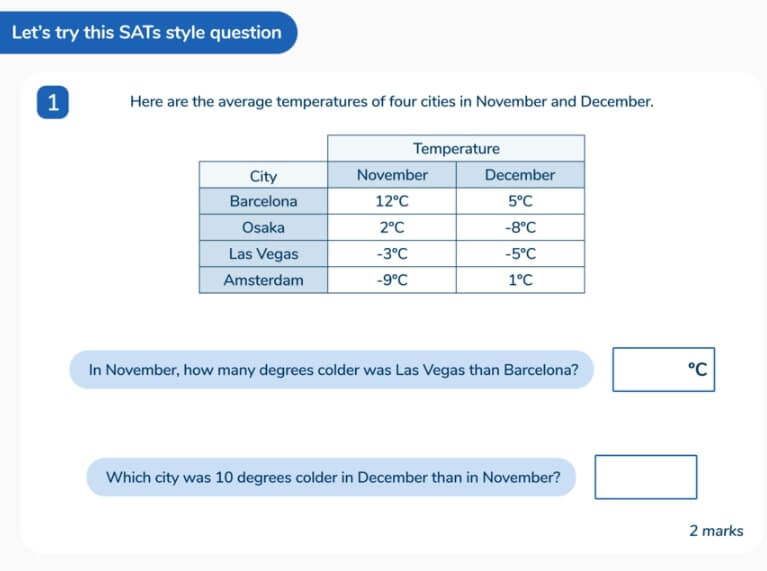
Read more
Online 1-to-1 maths lessons trusted by schools and teachers
Every week Third Space Learning’s maths specialist tutors support thousands of primary school children with weekly online 1-to-1 lessons and maths interventions. Since 2013 we’ve helped over 110,000 children become more confident, able mathematicians. Learn more or request a personalised quote to speak to us about your needs and how we can help.
Our online tuition for maths programme provides every child with their own professional one to one maths tutor


